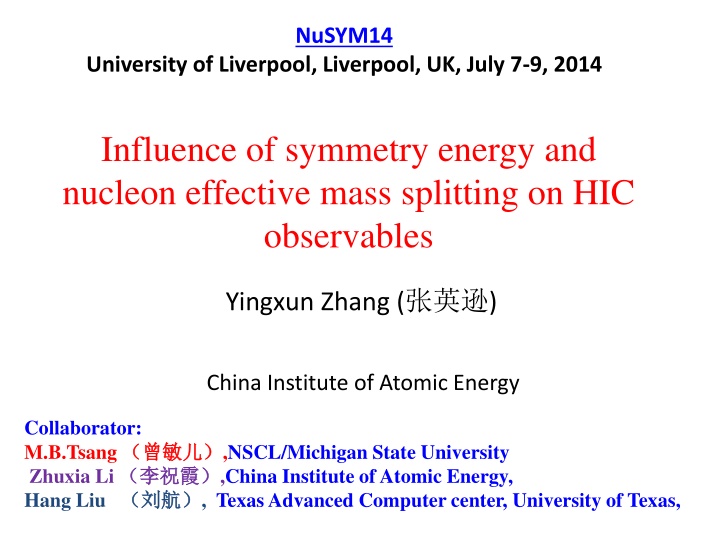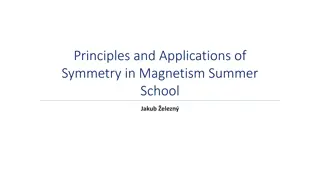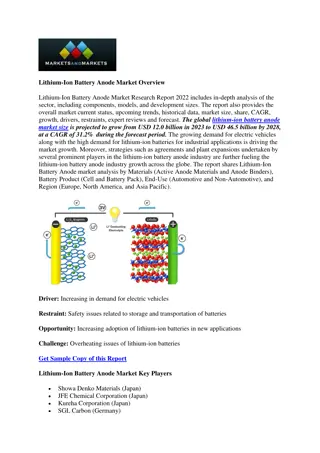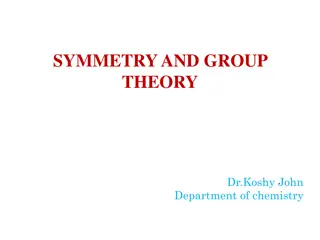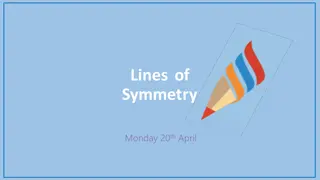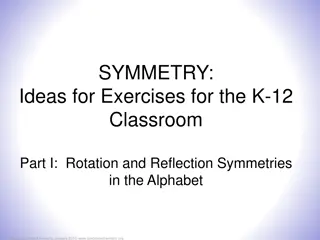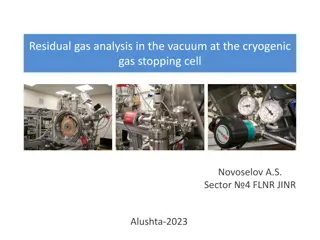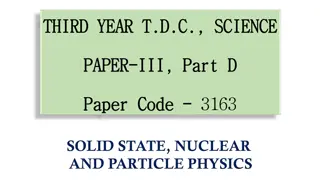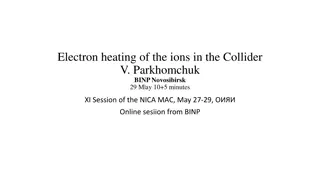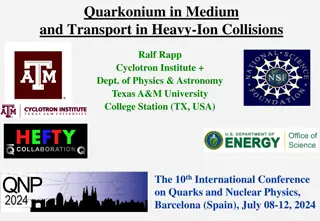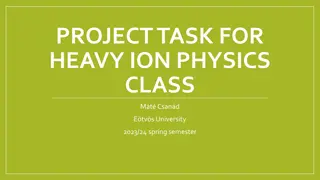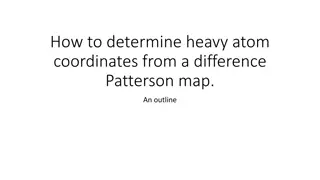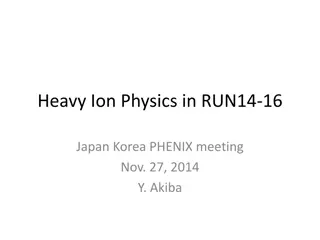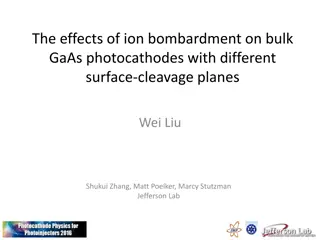Influence of Symmetry Energy on Heavy Ion Collision Observables
Study conducted at NuSYM14, University of Liverpool, focusing on the impact of symmetry energy and nucleon effective mass splitting on high-energy heavy ion collision observables. The research explores the density and momentum-dependent aspects of the equation of state in isospin-asymmetric systems.
Download Presentation

Please find below an Image/Link to download the presentation.
The content on the website is provided AS IS for your information and personal use only. It may not be sold, licensed, or shared on other websites without obtaining consent from the author.If you encounter any issues during the download, it is possible that the publisher has removed the file from their server.
You are allowed to download the files provided on this website for personal or commercial use, subject to the condition that they are used lawfully. All files are the property of their respective owners.
The content on the website is provided AS IS for your information and personal use only. It may not be sold, licensed, or shared on other websites without obtaining consent from the author.
E N D
Presentation Transcript
NuSYM14 University of Liverpool, Liverpool, UK, July 7-9, 2014 Influence of symmetry energy and nucleon effective mass splitting on HIC observables Yingxun Zhang ( ) China Institute of Atomic Energy Collaborator: M.B.Tsang ,NSCL/Michigan State University Zhuxia Li ,China Institute of Atomic Energy, Hang Liu , Texas Advanced Computer center, University of Texas,
Outline 1, Symmetry energy and n/p effective mass splitting 2, Influence of Skyrme force on HIC observables isospin diffusion and DR(n/p) ratios 3, Summary and outlook
Isospin asymmetric Equation of State ( ) , E = ( ) ( ) = + + 2 4 , 0 ( ) E S O It is a fundamental properties of nuclear matter, and is very important for understanding properties of nuclear structure properties of neutron star properties of heavy ion reaction mechanism S( ) (MeV) S( ) is the density dependence of symmetry energy, it is a key ingredient of the isospin asymmetric EOS. However, S( ) uncertainty Where is the uncertainty from? density dependent, momentum dependent, tensor force, exchange term, ..
Example, density dependent of symmetry energy from Skyrme interaction in HF: two-body term three-body term Mom. dependent Density dependent Symmetry energy depends on both the density dependent and momentum dependent (effective mass) term.
Effective mass: slope of single particle potential as a function of k. Effective mass: E-mass K-mass Effective mass splitting R. Chen et al., PRC 85, 024305 (2012).
Effective mass splitting WHLong, N Van Giai, J.Meng, PLB640(2008)150 RHF with PKO1
There is no strong correlation between effective mass splitting and slope of symmetry energy. We must constrain the L and effective mass splitting together.
Constraints on the n/p effective mass splitting (mn*>mp*) and symmetry energy (B.A.Li, C. Xu, et.al., PRC2006,2010). CXu,BALi,LWChen, PRC82,054607 Usym( 0,E)=22.75-0.21E mn*>mp* ( mn*-mp*)/m=0.32
Need more information on n/p effective mass splitting away from the normal density Sign of effective mass splitting can be changed with energy? ....... HICs (away from normal density and Fermi momentum), need transport model
Symmetry potential is direct input instead of symmetry energy in the transport models. probing the momentum dependence of symmetry potential(or n/p effective mass splitting) by HICs J.Rizzo, et.al., Phys.Rev.C (2005)
Here, we would like to investigate the influence of symmetry energy and n/p effective mass splitting on heavy ion collisions observables simultaneously by using the transport model calculations with Skyrme type interaction.
The reasons why we choose Skyrme interaction in transport models 1. The Skyrme parameter sets have been adjusted for fitting the properties of nuclear matter, binding energy, actinide fission barrier, masses, Thus, E0, K0, S0, L, Ksym, m*_s, m*_v, . are correlated. 2. In Skyrme EDF, one can easily choose different values L, m*_v for similar K_0 and S0, m*_s from lot of sets. 3. Same interaction as nuclear structure studies, one may compare the constraints from nuclear structure studies and reaction studies. 4. One could get the constraints on Skyrme parameters, also on symmetry energy and n/p effective mass splitting from reaction data simultaneously.
New version of ImQMD Y.X. Zhang, M.B.Tsang, Z.X. Li, HLiu, PLB(2014) Changes:
Select four parameter sets K0= 230 20MeV, S0= 32 2MeV, m*_s=0.7+/-0.1 different L and n/p effective mass splitting. J L Para. E0 K0 Q0 Ksym m*_s Rho_0 m*_n/m*_p SLy4 0.16 -15.97 229.91 363.11 32 46 -120 0.69 <1 SkI2 SkM* 0.158 0.16 -15.78 -15.77 240.93 216.61 339.70 386.09 33 30 104 71 46 0.68 0.79 <1 >1 -156 Gs 0.158 -15.59 237.29 348.79 31 93 14 0.78 >1 Small L Large L m_n*<m_p* SLy4 (L=46MeV) SkI2 (L=104MeV) m_n*>m_p* SkM* (L=46MeV) Gs (L=93MeV)
Below ~200MeV, optical potential for symmetric matter can be well approximated by Skyrme type interaction.
Corresponding density dependence of symmetry energy , and the symmetry potential as a function of nucleon energy Zhang, Tsang, Li, Liu,, PLB732,186(2014) The Larger the L is, the smaller the symmetry energy at <rho0 is. The larger the Usymis, the larger the n/p ratio is
Isospin diffusion and isospin transport ratios as a function of rapidity A=124Sn, B=112Sn Zhang, Tsang, Li, Liu,, PLB732,186(2014) Isospin diffusion occurs only in asymmetric systems A+B, and diffusion ability depends on the symmetry energy and n/p effective mass splitting. For m*n<m*p, the isospin diffusion process is accelerated due to larger Lane potential at subsaturation density. Ri=(2X-XAA-XBB)/(XAA-XBB) In absence of isospin diffusion R=1 or R=-1, R~0 for isospin equilibrium Ri(SLy4, L=46MeV, m*_n<m*_p)<Ri(SkM*, L=46MeV, m*_n>m*_p) < Ri(SkI2, L=104MeV, m*_n<m*_p)<Ri(Gs, L=93MeV, m*_n>m*_p) Riis more sensitive to L than n/p effective mass splitting.
The calculated results of Ri from SLy4 and SkM* can fall in the data range. For SLy4 and SkM*, they have S0=30-32MeV, L=46MeV Isospin diffusion data is hard to distinguish the effective mass splitting
n/p and DR(n/p) ratios as a function of kinetic energy / dM dE = = ( / ) ( ) n k R Y n Y p DR(n/p)=Rn/p(124)/Rn/p(112) / n p / dM dE p k 50AMeV, b=2fm The Larger the L is, the smaller the n/p ratio is. m*n<m*penhance the Y(n)/Y(p) ratios at higher kinetic energy region. DR(n/p) ratios are sensitive to the n/p effective mass splitting. Y(n)/Y(p) and DR(n/p) are more sensitive to n/p effective mass splitting than L
n/p and DR(n/p) at different beam energy Cross over SLy4 (S0=32MeV, L=46MeV, m*n<m*p) SkM*(S0=30MeV, L=46MeV, m*n>m*p) the Y(n)/Y(p) obtained with m*n>m*p are greater than that with m*n<m*pcases at lower beam energy for higher beam energy.
Theoretical predictions and New data D.D.S.Coupland, et al., arXiv:1406.4546 New data seems to favor small effective mass splitting at high momentum need more calculations with different effective mass splitting to understand this difference.
Separately change the effective mass splitting values in the code input variables for ImQMD, as same as in MSL MSL parameters, L.W.Chen, et al., PRC82, 024321(2010) parameters default Rho0 0.16 E0 (MeV) -16 K0 (MeV) 230 280 330 Ms* 0.7 0.85 1.0 Mv* 0.6 0.7 0.8 S0(MeV) L (MeV) 32 30 34 46 60 80 100 G_sur (MeVfm^2) 24.6 G_sur,iso (MeVfm^2) -4.99 Xs*/xs_free 1-eta*rho (mu*/mu)^2 1
Coalescence invariant Y(n)/Y(p) ratio, at Ebeam=50AMeV, b=2fm CI-Y(n)/Y(p) ratio is sensitive to effective mass splitting (mv*), L and S0at 50AMeV. CI-Y(n)/Y(p) weakly depends on K0, ms*, and in-medium xs.
Coalescence invariant Y(n)/Y(p) ratio, at Ebeam=120AMeV, b=2fm CI-Y(n)/Y(p) ratio at high energy region is sensitive to effective mass splitting (mv*) at 120AMeV. CI-Y(n)/Y(p) weakly depends on K0, S0, L, ms*, and in-medium xs.
4, Summary and outlook 1, Developed a new version of ImQMD which can accommodate the Standard Skyrme interaction in parameters. It can bridge the reaction and structure study by using same EDF. 2, The Ri and Ri(y) support the SLy4 and SkM* interactions, they have L=46MeV. 3, CI-Y(n)/Y(p) ratio is sensitive to S0, L and effective mass splitting (mv*) at 50AMeV, and weakly depends on K0, ms*, and in-medium xs. 4, CI-Y(n)/Y(p) ratio at high energy region is sensitive to effective mass splitting (mv*) at 120AMeV, and weakly depends on the K0, S0, L, ms*, and in-medium xs. 5, the behaviors of symmetry potential at high momentum should be further understand.
Charge distribution Weak dependence on the parameters we selected Ebeam=50AMeV
